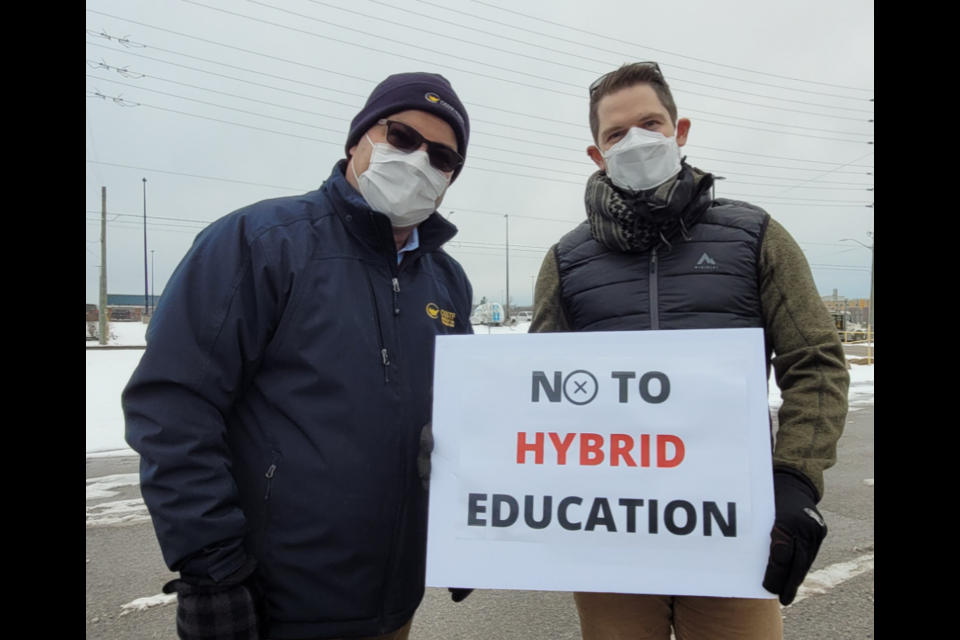A teacher-led rally against hybrid learning in Simcoe County high schools had around two dozen people voicing their concerns out in the cold on Wednesday afternoon in south-end Barrie.
Hybrid learning, which combines both online and in-school options into one classroom, was introduced in February 2021 in the region, but with classes stopping because of rising COVID-19 cases at the time, the model only lasted until about April. This academic year, starting in September, hybrid learning is happening in Simcoe County District School Board secondary schools.
Steve Thiele-Auntz has been teaching Grade 10 history in a hybrid classroom since September at Nottawasaga Pines Secondary School in Angus. He has an in-person classroom of 22 kids and one who learns via the hybrid option.
Thiele-Auntz says the main problem is communication.
“Being able to engage with the hybrid student is extremely difficult, as I am trying to do the same with 22 other students who are in person and asking questions or speaking to the lesson," Thiele-Auntz told BarrieToday at today's rally near Sadlon Arena.
"If I take my attention from the 22, they lose interest and likewise for the student who is online,” he added.
Thiele-Auntz says something needs to be done soon about the hyrbid teaching model and soon.
“I see a lot of anxiety about being in a classroom virtually while many others are in person," he said. "We have to find a way to get these kids face-to-face with a teacher somehow, even virtually, because they are not getting the proper learning experience in the hybrid system."
Jennifer Behan, who is an English teacher at Bear Creek Secondary School in south-end Barrie, said she's not currently teaching a hybrid class, but did last year and was also part of the hybrid task force.
“Having taught in a hybrid classroom, I can say it is a huge undertaking and the divided attention is causing many kids to not get the education they need and deserve,” she said. “This is my 24th year in teaching and one of the most important things you get to realize over that time is once a kid is distracted, it is so hard to get them back to being engaged.”
Earlier Wednesday, board spokesperson Sarah Kekewich said that while there are a few circumstances where hybrid learning is occurring in county schools, “for the most part students who are learning remotely are taking e-learning courses.”
Ontario Secondary School Teachers' Federation (OSSTF) District 17 bargaining unit president Jen Hare admits there has been a reduction of hybrid students who have stayed in that learning platform, but said hybrid classes are still very much an issue.
“We still have at least a dozen or more classes in each school. Sometimes up to 80 to 100 classes in a school will have a hybrid learner in it,” Hare said. “Every student should have the ability to have a dedicated teacher, someone to be with them one-on-one, to teach a lesson, to check on their mental health, and be their constant teacher.”
Hare said she would like to see a strictly virtual option for kids who want to be taught from home, and the in-person learning to continue for those who want to be in school.
“We need schools to be open, we know there is power to public education, and we don't want to see another shutdown,” she said. “What we need is a teacher and a dedicated e-learning class for those online students. We want a fully functional virtual school dedicated to the online students."
But Hare also knows that could come with a hefty price tag.
“It's expensive and it would come down to the money of it, even though it is crucial to teach kids properly,” she said.



